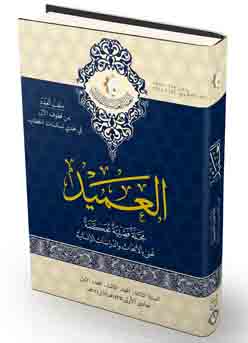Abstract
This article aims to display the image of Prophet Mohammad (pbuh) in the poetry of his contemporaries، particularly Hassan Bin Sabet، Kaeb Bin Zuhair، and Kaeb Bin Malek Al-Ansari and take into account their different understandings of the Prophet (pbuh) which set their perspectives apart respectively regarding him as both a Prophet and a messenger. Moreover، their recital of poetry during both ages is considered، and it is psychologically natural for them not to lose all the values stuck to their minds during the Ignorance Age. Through their poetry، we will deduce how they employed their inherited ethical norms، which were morally regarded as high in the Age of Ignorance، to speak well of the Prophet، lamented him، and ridiculed his enemies as they take into consideration his niche in the Quranic text and the idea that those who follow poets are lost، excluding those who believe and support the his message.
What are the traditional qualities used by the three poets to describe the Prophet (pbuh)? What were the newer qualities derived from the message? How did each one of them express these qualities when they embraced Islam? How much of his teachings were they able to understand? Here we note the difference between the newly converted Kaeb Bin Zuhair’s praise and the Ansar’s ، and then the difference between Hassan’s poetry
- already being an elder by the time he converted to Islam - and the poetry of Kaeb who was still young when he was honoured with Islam. It is to conclude that the disparity between these poets’ visions of the Prophet is but a minimized picture of the heightened disparity between the levels in which his contemporaries understood him.
What are the traditional qualities used by the three poets to describe the Prophet (pbuh)? What were the newer qualities derived from the message? How did each one of them express these qualities when they embraced Islam? How much of his teachings were they able to understand? Here we note the difference between the newly converted Kaeb Bin Zuhair’s praise and the Ansar’s ، and then the difference between Hassan’s poetry
- already being an elder by the time he converted to Islam - and the poetry of Kaeb who was still young when he was honoured with Islam. It is to conclude that the disparity between these poets’ visions of the Prophet is but a minimized picture of the heightened disparity between the levels in which his contemporaries understood him.
Keywords
The Age of Ignorance – The Era of Islam – Patterned (typical) qualities – Traditional qualities – Islamic qualities – Praise – Lamentation – The Quranic text.
Abstract
إنّ هذه المقالةَ تهدف إلى تبيان صورة النبيّ محمّد (o) في أشعار معاصريه، لاسيّما حسّان بن ثابت، وكعب بن زهير، وكعب بن مالك الأنصاريّ، مع الأخذ في الحسبان الاختلاف في كيفيّة فهم كلّ واح ﹴد من هؤلاء الشعراء الثلاثة لدور محم ﹴد (o) نبيّا ورسولًا ، كونهم من الشعراء المخﴬمين ، الذي عاشوا جزءًا من حياتهم في الجاهليّة )طال أم قصَُر( وجزءًا في الاسلام ، وقالوا الشعرَ في المرحلتَين ، و كان طبيع ﹼﹰيا أن لم يكن بإمكانهم نفس ﹼﹰيا التخلّي بين ليل ﹴة وضحاها، عن كلّ ما علق في أذهانهم من قِيَمِ الجاهليّة ) شأنهم في ذلك شأن معظمِ الذين أسلموا وهم كبا ﹲر في السنّ ( . وسنرى من استقراء أشعارهم ، كيف وظّفوا المزايا الأخلاقيّة النمطيّة الموروثة ، والتي كانت تُعدّ من مكارم الأخلاق في العصر الجاهلّي في مدحهم للنبيّ ، وفي رثائه ،وكذلك في هجائهم لأعدائه ،مع الأخذ في الحسبان الدور الذي رسمه النصّ القرآنّي للشاعر، عندما وصف الشعراء أنّهم يتّبعهم الغاوون ، واستثنى الذين آمنوا منهم ونصروا الرسالة . ماهي الأوصاف التقليديّة التي وصف هؤلاء الشعراء الثلاثة النبيَّ (o) بها ؟ وما الأوصاف الجديدة
المستمدّة من الرسالة ؟ وكيف عبّ عنها ك ﱡل واح ﹴد منهم انطلاقًا من تاريخ اعتناقه
الإسلامَ ،ومقدار فهمه لتعاليمه ؟ وهنا نلحﻆُ الفرقَ بين مدحيّة كعب بن زهير الحديثِ
إسلامهُ و مدائح الأنصاريَّ ﹾين ، ومن ثمَّ الفرق بين أشعار حسّان الذي كان مسنﹼﹰا حين أسلمَ وأشعار كعب الذي كان ما يزال شا ﹼﹰباعند تشّرفه باعتناق الاسلام لنصلَ إلى نتيج ﹴة
مفاُدها أنّ التفاوتَ في رؤيةِ هؤلاء الشعراء الثلاثة إلى النبيّ، إنّما هو صور ﹲة مصغّر ﹲة للتفاوت القائم بين مستويات فهم معاصريه له ــ ومن ضمنهم صحابتُه ــ وتاليًا التفاوت في فهمهم لرسالته.
المستمدّة من الرسالة ؟ وكيف عبّ عنها ك ﱡل واح ﹴد منهم انطلاقًا من تاريخ اعتناقه
الإسلامَ ،ومقدار فهمه لتعاليمه ؟ وهنا نلحﻆُ الفرقَ بين مدحيّة كعب بن زهير الحديثِ
إسلامهُ و مدائح الأنصاريَّ ﹾين ، ومن ثمَّ الفرق بين أشعار حسّان الذي كان مسنﹼﹰا حين أسلمَ وأشعار كعب الذي كان ما يزال شا ﹼﹰباعند تشّرفه باعتناق الاسلام لنصلَ إلى نتيج ﹴة
مفاُدها أنّ التفاوتَ في رؤيةِ هؤلاء الشعراء الثلاثة إلى النبيّ، إنّما هو صور ﹲة مصغّر ﹲة للتفاوت القائم بين مستويات فهم معاصريه له ــ ومن ضمنهم صحابتُه ــ وتاليًا التفاوت في فهمهم لرسالته.
Keywords
صورة النّبيّ في شعر معاصريه ــ العصر الجاهلّي ـ عصر صدر الاسلام
